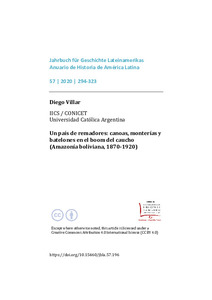Please use this identifier to cite or link to this item:
https://repositorio.uca.edu.ar/handle/123456789/11488| Título: | Un país de remadores : canoas, monterías y batelones en el boom del caucho (Amazonía boliviana, 1870-1920) A country of paddlers : canoes, hunts and battles in the rubber boom (Bolivian Amazon, 1870-1920) |
Autor: | Villar, Diego | Palabras clave: | RIOS; CAUCHO; NAVEGACION; INDUSTRIA DEL CAUCHO; DERECHO LABORAL; DERECHO CIVIL | Fecha de publicación: | 2020 | Editorial: | Hamburg University Press | Cita: | Villar, D. Un país de remadores : canoas, monterías y batelones en el boom del caucho (Amazonía boliviana, 1870-1920) [en línea]. Jahrbuch für Geschichte Lateinamerikas. 2020, 57. Doi: 10.15460/jbla.57.196. Disponible en: https://repositorio.uca.edu.ar/handle/123456789/11488 | Resumen: | Resumen: Se analiza una serie de fuentes históricas (caucheros, viajeros, exploradores, naturalistas, militares, misioneros) para describir el fenómeno de la navegación a remo durante el boom de la goma en la Amazonía boliviana (1870-1920). Se describen las características técnicas de las embarcaciones y la propia labor de la navegación, los obstáculos geográficos y naturales, las inestables condiciones laborales, el sustrato sociológico y étnico de la mano de obra fluvial y las ambigüedades del extractivismo gomero. Asimismo, se analiza la combinación de factores técnicos de la navegación amazónica, la escasez de mano de obra y la demanda regional y mundial de caucho que generaron un contexto específico en el cual las tripulaciones fluviales ganaron progresivamente autonomía, un cierto margen de maniobra y una serie de derechos laborales y civiles. Abstract: The paper analyzes historical sources (rubber tappers, travelers, explorer, scientific, military, and missionary accounts) in order to describe rowing navigation during the rubber boom in Bolivian Amazonia (1870-1920). Technical features of several types of boats are described, as well as the navigation skills involved, the unstable labor conditions, the natural and geographical obstacles, the sociological and ethnic substratum of the fluvial workforce and some of the dilemmas and ambiguities of rubber extractivism. Then the paper analyses the combination of specific navigation factors, the scarcity of labor and the regional and global demand of rubber that helped the fluvial crews to gain gradually strategic autonomy and a set of civil and laboring rights. |
Cobertura Espacial: | Amazonia Bolivia |
Cobertura Temporal: | SIGLO XX SIGLO XIX |
URI: | https://repositorio.uca.edu.ar/handle/123456789/11488 | ISSN: | 1438-4752 | Disciplina: | CIENCIAS SOCIALES | DOI: | 10.15460/jbla.57.196 | Derechos: | Acceso abierto | Fuente: | Jahrbuch für Geschichte Lateinamerikas. 2020, 57 |
| Appears in Collections: | Artículos |
Files in This Item:
| File | Description | Size | Format | |
|---|---|---|---|---|
| pais-remadores-canoas-monterias.pdf | 441,12 kB | Adobe PDF |  View/Open |
Page view(s)
300
checked on Apr 30, 2024
Download(s)
164
checked on Apr 30, 2024
Google ScholarTM
Check
Altmetric
Altmetric
This item is licensed under a Creative Commons License

